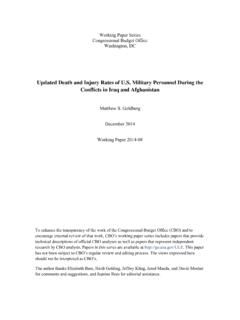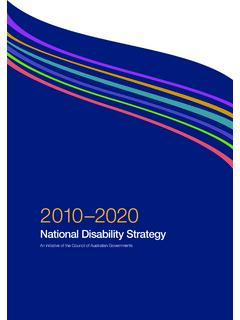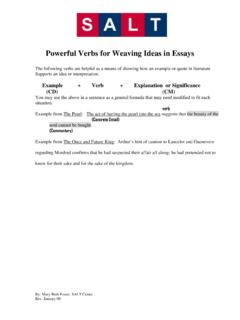Transcription of CONTENTS
1 CONTENTS 1. INTRODUCTION .. 1 2. SPENDING REVIEWS .. 3 3. PRINCIPLES FOR THE 2021 MTEF .. 4 4. budget SUBMISSION .. 5 PROCESS .. 5 5. COMPONENTS OF SUBMISSION .. 6 NARRATIVE REPORT .. 6 DATA SUBMISSIONS .. 8 6. OTHER SUBMISSIONS .. 9 CRITICAL 2021 budget PROCESS 11 ANNEXURE A: RESOURCE ALLOCATION PROCESS STEPS .. 12 ANNEXURE B: budget PROCESS TECHNICAL AND POLITICAL STRUCTURES 14 ANNEXURE C: FUNCTION GROUPS .. 17 2021 MTEF Technical Guidelines 1 1. INTRODUCTION The Medium -Term Expenditure Framework (MTEF) Technical Guidelines provide public institutions with guidance on how to prepare their medium-term budget estimates for the 2021 budget .
2 The guidelines are issued in accordance with section 27(3) of the Public Finance Management Act (PFMA), Act No. 1 of 1999. The guidelines are primarily intended for national government departments and public institutions1 and may contribute to the budgeting process in provinces. Since 2008/09, there has been a large and growing gap between government spending and tax revenues, resulting in exponential growth in borrowing to fund the fiscal gap. In response, government has taken steps to reduce non-interest spending growth and raise tax revenue. However, due to lower nominal GDP and revenue growth, these interventions have not stabilised debt.
3 Debt-service costs continue to be the fastest-growing area of spending, accounting for 21 cents out of every rand of government revenue raised in 2020/21. Over these years, the stock of government net loan debt rose six-fold from under R500 billion in 2007/08 to nearly R3 trillion at the end of 2019/20. COVID-19 has further exacerbated the precariousness of the public finances, which had already reached an unsustainable position before the pandemic. As indicated in the Supplementary budget Review the economy is expected to contract by per cent this year. All sectors have experienced a sharp downturn and millions of jobs are at risk, while millions of households are going through increasing hardships.
4 Government has had to deploy a range of fiscal and monetary measures to address the adverse effects of the pandemic, limit the economic damage, and support recovery. Nevertheless, the current spending path implies that fiscal deficits would remain higher than 12 percent of GDP for the foreseeable future. This is a key reason for South Africa losing its investment-grade credit rating by all ratings agencies. Allowing fiscal buffers to weaken hampers South Africa s policy response to shocks, including the current pandemic, and government has resolved that this should be rectified going forward. Such high deficits place enormous pressure on South Africa s financial sector and the real economy.
5 With savings levels quite low, high government deficits will expose the country to higher borrowing risks, push interest rates upward and extract from growth through lower private sector investments. In the event of a debt default or fiscal crisis, the National Treasury has estimated that this would cost the country at least R2 trillion in lost economic activity by the end of the decade. 1 Public institutions including public entities, trading entities, government components and constitutional institutions need to provide budget information to National departments and National Treasury.
6 Constitutional institutions may also approach the National Treasury directly regarding their budget submission. 2021 MTEF Technical Guidelines 2 Gross tax revenue for the 2020/21 fiscal year is revised down from trillion to trillion, which creates a billion shortfall. The 2021 MTEF will achieve R230 billion in savings over the first two years, beginning with R90 billion reduction in overall non-interest spending in 2021/22. The 2023/24 baseline will carry through these measures, with the aim of achieving a primary surplus and stabilising debt in that year. If these reductions are not achieved, and fiscal consolidation is unsuccessful, government debt will exceed 100 per cent of GDP in the medium-term.
7 This will signal the emergence of debt distress episodes as a vicious cycle of high borrowing rates and low growth leading to ever deeper debt spirals, lower investment and lower economic output. Targeting sustainable public finances is also critical for maintaining policy flexibility and sovereignty, as harsher measures will be required by lenders of last resort. Table 1 South Africa s economy is resilient and can be rebuilt and stabilised. For the purposes of the medium-term, measures towards fiscal consolidation and debt stabilisation should be accompanied by a refocusing of spending from consumption to investment in strategic economic infrastructure.
8 The National Treasury in collaboration with departments will be undertaking spending reviews to contribute to the fiscal consolidation process. In this regard, there should be no holy cows and no spending items will be automatically protected from possible downward adjustments. Active scenario medium term- budget balances2020/212021/222022/23R billion/percentage of GDPR evisedMedium-term estimatesMain budget budget budget : National Treasury2021 MTEF Technical Guidelines 3 2. SPENDING REVIEWS It has been some years since the introduction of the MTEF budgeting process in the 1999/2000 budget . Since then government has created numerous spending programmes, with limited review of their effectiveness and appropriateness in the current environment.
9 The Minister in the budget speech indicated that spending reviews will be undertaken to ensure effective use of limited resources. Therefore, a series of spending reviews will be conducted in this current budget cycle in line with the active scenario approach. The envisaged spending reviews provide a detailed understanding of policy and programme logic, which is combined with available expenditure data from government (BAS, PERSAL, Management Accounts). In a series of systematised steps, expenditure is analysed, unit costs are clarified and cost drivers are recognised. This analysis aims to provide a thorough understanding of baselines and a strong empirical base for clear recommendations to decision-makers.
10 budget tagging definition: it is a tool that identifies, classifies, weights and marks relevant expenditures in a government s budget system, enabling the estimation, monitoring and tracking of those expenditures by providing data on government s allocations or existing spending. Information gathered via tagging will be used to inform policy discussions. Climate change The 2020 budget Review highlighted the risk of reactionary measures to combat climate change. As extreme weather patterns are becoming more frequent as a result of climate change, climate damage on infrastructure and economic sectors have put basic services and infrastructure under threat, which in turn strain public budgets.















